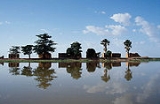
Lake Débo
Encyclopedia
Lake Débo is a lake
in central part of Mali
, formed by the seasonal flooding of the Niger River
basin.
on its upstream end and 240 km from Timbuktu
at its downstream end. It is the largest of many such seasonal wetlands and lakes which form the Inner Niger Delta, and the largest lake in Mali. It is largely reduced during the September to March dry season
.
and Bani River
s, the lake is intesively trawled by the ethnic Bozo
fisherman who live along its shores, while in the dry season, the many ethnic Fula
nomads and their herds from the north end their transhumance
migration here.

has classified it as a RAMSAR
zone (The Convention on Wetlands of International Importance, especially as Waterfowl Habitat, zone humide reconnue d’un intérêt international pour la migration des oiseaux d’eau)
Lake
A lake is a body of relatively still fresh or salt water of considerable size, localized in a basin, that is surrounded by land. Lakes are inland and not part of the ocean and therefore are distinct from lagoons, and are larger and deeper than ponds. Lakes can be contrasted with rivers or streams,...
in central part of Mali
Mali
Mali , officially the Republic of Mali , is a landlocked country in Western Africa. Mali borders Algeria on the north, Niger on the east, Burkina Faso and the Côte d'Ivoire on the south, Guinea on the south-west, and Senegal and Mauritania on the west. Its size is just over 1,240,000 km² with...
, formed by the seasonal flooding of the Niger River
Niger River
The Niger River is the principal river of western Africa, extending about . Its drainage basin is in area. Its source is in the Guinea Highlands in southeastern Guinea...
basin.
Extent
Lake Débo, at its greatest extent, lies around 80 km from MoptiMopti
Mopti is a city at the confluence of the Niger and the Bani in Mali, between Timbuktu and Ségou. The city lies on three islands linked by dykes: the New Town, the Old Town and Medina Coura. As a result it is sometimes known as the "Venice of Mali".-History:The city of Mopti derives its name from...
on its upstream end and 240 km from Timbuktu
Timbuktu
Timbuktu , formerly also spelled Timbuctoo, is a town in the West African nation of Mali situated north of the River Niger on the southern edge of the Sahara Desert. The town is the capital of the Timbuktu Region, one of the eight administrative regions of Mali...
at its downstream end. It is the largest of many such seasonal wetlands and lakes which form the Inner Niger Delta, and the largest lake in Mali. It is largely reduced during the September to March dry season
Dry season
The dry season is a term commonly used when describing the weather in the tropics. The weather in the tropics is dominated by the tropical rain belt, which oscillates from the northern to the southern tropics over the course of the year...
.
Usage
During the seasonal floods of the NigerNiger River
The Niger River is the principal river of western Africa, extending about . Its drainage basin is in area. Its source is in the Guinea Highlands in southeastern Guinea...
and Bani River
Bani River
The Bani River is the principal tributary of the Niger River in Mali. Its length is about 1100 km. The Bani is formed from the confluence of the Baoulé and Bagoé rivers some 160 km east of Bamako and merges with the Niger near Mopti.-Geography:...
s, the lake is intesively trawled by the ethnic Bozo
Bozo people
The Bozo are a West African ethnic group located predominantly along the Niger River in Mali. The name Bozo is thought to derive from Bambara bo-so, 'Bamboo house'; the people accept it as referring to the whole of the ethnic group but use more specific clan names such as Sorogoye, Hain, and Tieye...
fisherman who live along its shores, while in the dry season, the many ethnic Fula
Fula people
Fula people or Fulani or Fulbe are an ethnic group spread over many countries, predominantly in West Africa, but found also in Central Africa and Sudanese North Africa...
nomads and their herds from the north end their transhumance
Transhumance
Transhumance is the seasonal movement of people with their livestock between fixed summer and winter pastures. In montane regions it implies movement between higher pastures in summer and to lower valleys in winter. Herders have a permanent home, typically in valleys. Only the herds travel, with...
migration here.

Habitat
The lake is also an important stopping place for Migratory birds, and UNESCOUNESCO
The United Nations Educational, Scientific and Cultural Organization is a specialized agency of the United Nations...
has classified it as a RAMSAR
Ramsar
Ramsar is a city in and the capital of Ramsar County, Mazandaran Province, Iran. At the 2006 census, its population was 31,659, in 9,421 families....
zone (The Convention on Wetlands of International Importance, especially as Waterfowl Habitat, zone humide reconnue d’un intérêt international pour la migration des oiseaux d’eau)

